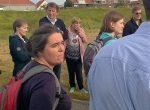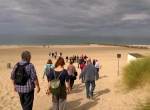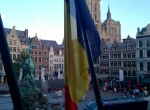Sachensymposion - annual conference in Antwerp
2016.10.13 -
On 17-21st September 2016 Antwerp was the venue of the 67th Internationales Sachsensymposion, annual encounter of archaeologists concerned with the early medieval West Europe, including the Baltic region. A conference with a great tradition and prestige. The leading theme were water routes, exchange and communication during the early Middle Ages. There were 95 archaeologists among the conference participants who presented 33 papers. Most of the participants hailed from England, Scandinavia, Germany and the Benelux. Poland was represented by six people, two of them MPOV team members (M. Przybyła and M. Mączyńska). Prof. dr hab. Wojciech Nowakowski (UW) read a paper on the Vistula as a border river in classical and early medieval geography, and compared historical sources with archaeological ones, with special focus on the role of the Lower Vistula and intensive settlement of the last stage of the Amber Road. Dr Marzena Przybyła and lic. Ewa Rydzewska (UJ) presented notes about amber beads which in Scandinavia and northern Germany were a counterpart of obols found in graves, offerings to the dead (“passage money”), similarly as gold plaques and shards of Roman glass vessels. Dr hab. Adam Cieśliński (UW) illustrated the distribution of Roman Period barrow cemeteries in Pomerania in relation to rivers flowing nearby, using the GIS method, in a presentation developed with co-authors Karin Göbel and Jörg Novotny from Schleswig. Last but definitely not least, prof. dr hab. Magdalena Mączyńska reported on an experiment to separate phase C 3 in the Wielbark culture – in other words, to mark off the final phase of the Roman Period (310-370) from the early Migration Period.
The main focus of interest in most of the papers was the Carolingian Age, also one a key theme of a one-day excursion from Antwerp to the province of Zeeland (the Netherlands) at the mouth of the Maas and the Scheldt. We toured some early medieval and medieval ringforts and listened, on the headland of Walcheren on the shore of the North Sea, to two extensive accounts of the Roman presence in this region, ports, exports of salt, fish sauce and clams to Gaul and Britain, and also, of the remains of temples to the local goddess Nehalennia, long swallowed by the sea. In Middelburg, the capital of the province of Zeeland, were taken to the Archaeological Depot to view original metal and ceramic finds from the Carolingian period.
The next conference will be held in 2017 in Canterbury, its main focus - the fifth and the sixth centuries, and what is important for us – the archaeology of countries on the Baltic Sea will be taken into account.
MM





